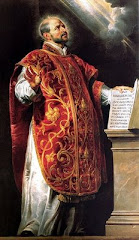Fr. Robert Barron at Mundelein Seminary writes a good article for America about his missionary apostolate on YouTube and the most frequent adversaries to his videos. The last two offer good reflection on how we go about reading scripture. These questions come up often enough in my scripture class and in regular conversation and represent common misunderstandings even among well educated Catholics on how to actually go about reading the Bible.
A third heresy is biblical fundamentalism. I hear from my YouTube opponents that the Bible is a mishmash of "bronze-age myths” (Christopher Hitchens) and childish nonsense about talking snakes, a 5,000-year-old universe and a man living three days inside of a fish. I observe in reply that the Bible is no so much a book as a library, made up of texts from a wide variety of genres and written at different times for varying audiences. Just as one would not take "the library” literally, one should not interpret the whole Bible with one set of lenses.
I like this image of a library, an inspired library of course. It is full of many kinds of writing, many of which we still do not fully know how to classify. It is made up of inspired myth, genealogical fragments, works of fiction, etc. One takes the library literally only by understanding the type of literature that one decides to check out. It is ready literally according to its genre.
My YouTube conversation partners typically fire back that I am proposing a novelty in order to respond to the attacks of modern critics. I try to steer them to Irenaeus (second c.), Origen (third c.) and Augustine (fourth c.), all of whom dealt with the complexity of the Bible through the exercise of a deft hermeneutic. Some of those who appreciate the library analogy wonder how one would decide which kind of text one is dealing with and hence which set of interpretive lenses to wear. I respond that their good question proves the legitimacy of the Catholic Church's assumption that the church-that variegated community of interpretation stretching over 20 centuries - is required for effective biblical reading today. I ask, How do you know the difference between Winnie the Pooh, The Brothers Karamazov, the Divine Comedy, Carl Sandburg's Lincoln and Gore Vidal's Lincoln? Then I answer my own question: You have been taught by a long and disciplined tradition of interpretation. Something similar is at play in authentic biblical reading.
Very well said.
The fourth YouTube heresy is Marcionism, which brings us back to one of Irenaeus's principal opponents, Marcion. He held that the New Testament represented the revelation of the true God, but that the Old Testament was the revelation of a pathetic demigod marked by pettiness, jealousy and violence. This ancient heresy reappears practically intact on the YouTube forums. My interlocutors complain about the morally offensive, vain, psychotic and violent God of the Old Testament, who commands that a ban be put on cities, who orders genocide so that his people can take possession of the Promised Land, who commands that children's heads be dashed against stones. In the wake of the terrorist attacks on Sept. 11, 2001, this complaint becomes more pointed. If I gesture toward the wisdom of the biblical tradition, I am met with this objection.I urge my respondents to read the entire Bible in the light of Christ crucified and risen from the dead. I tell them of an image in the Book of Revelation of a lamb standing as though slain. When no one else in the heavenly court is able to open the scroll that symbolizes all of salvation history, the lamb alone succeeds. This indicates that the nonviolent Christ, who took upon himself the sin of the world and returned in forgiving love, is the interpretive key to the Bible. It was in this light that Origen, for example, read the texts concerning the Old Testament ban as an allegory about the struggle against sin. The bottom line is this: One should never drive a wedge between the two testaments instead, one should allow Christ to be the structuring logic of the entire Scripture.What is blocking the preaching of the faith, especially to younger people? Many things. But I would suggest that preachers, teachers, evangelists and catechists might attend with some care to these four.
The other two he mentions are Scientism and Ecclesial Angelism, or the idea that because the Church has done bad things it must be discredited.
Nathan O'Halloran, SJ


















No comments:
Post a Comment